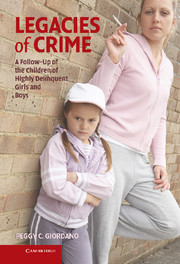Book contents
- Frontmatter
- Contents
- Acknowledgments
- 1 Introduction
- 2 Literature Review and Conceptual Framework
- 3 The Ohio Life-Course Study
- 4 OLS Adult Respondents: Offending, Surviving, Parenting
- 5 How Have the OLS Children Fared?
- 6 The Intergenerational Transmission Process
- 7 “Success Stories”: It's All Relative
- 8 Theoretical and Policy Implications of the OLS Study
- References
- Index
2 - Literature Review and Conceptual Framework
Published online by Cambridge University Press: 05 June 2012
- Frontmatter
- Contents
- Acknowledgments
- 1 Introduction
- 2 Literature Review and Conceptual Framework
- 3 The Ohio Life-Course Study
- 4 OLS Adult Respondents: Offending, Surviving, Parenting
- 5 How Have the OLS Children Fared?
- 6 The Intergenerational Transmission Process
- 7 “Success Stories”: It's All Relative
- 8 Theoretical and Policy Implications of the OLS Study
- References
- Index
Summary
While it is intuitive to expect that parental criminality will have an influence on children's behavior (the apple doesn't fall far from the tree), surprisingly little research has focused directly on the intergenerational transmission process itself. Most of what we know about patterns of crime over two generations is based on retrospective studies: researchers have shown that delinquents are more likely than conforming youth to have a parent with a criminal history. Parental criminality is thus a well-accepted risk factor for juvenile delinquency. Follow-up studies pose a related but less often researched question: when we track juvenile delinquents through their transition to adulthood, what happens to their children? Prospective studies of this type are not as plentiful, if only for practical reasons, that is, it takes a long time for the young people originally studied to mature, find romantic partners, have children, and then for their children to reach an age when their own delinquent acts begin to occur.
Several recent longitudinal studies have been underway long enough to incorporate assessments of the behaviors of the children of the original respondents, and both the classic risk-factor studies and these more contemporary prospective investigations provide a useful background for the current study. While both kinds of studies have documented links between the behavior of one generation and of the next, we conclude from our review of the literature that our understanding of the mechanisms underlying intergenerational transmission is nevertheless markedly less than complete.
- Type
- Chapter
- Information
- Legacies of CrimeA Follow-Up of the Children of Highly Delinquent Girls and Boys, pp. 7 - 34Publisher: Cambridge University PressPrint publication year: 2010



